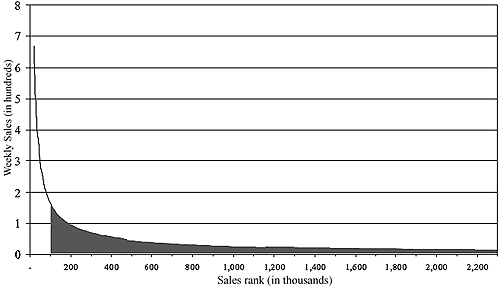The long tail was illustrated in a 2003 paper by Eric Brynjolfsson and his colleagues. Based on a sample of Amazon.Com book sales, they made the following estimates of the proportion of sales from obscure titles at Amazon:
Sales rank Percent of sales >40,000 47.9% >100,000 39.2% >250,000 29.3%
As you see, they estimated that nearly half of Amazon's sales were made from titles ranked greater than 40,000th in sales. The graph on the right shows their overall sales estimate distribution.
The long tail has been used to describe other Internet phenomena. For example, a large percent of Google's ad revenue comes from advertising by millions of small, often local companies paying just a few cents per click (AdWords) or millions of Web sites which display Google ads (AdSense).
This article discusses AdWords and the advertiser ranking algorithm Google uses.
Another example is in the emerging Web services market, where many people feel there will be a very large number of specialized components with relatively few users.
This idea has been extended and popularized by Chris Anderson.

Estimated weekly sales versus popularity ranking.
Source: Brynjolfsson, E, M. Smith, and Y. Hu, Consumer Surplus in the Digital Economy: Estimating the Value of Increased Product Variety at Online Booksellers, MIT Sloan School of Management, Working Paper 4305-03, June 2003.